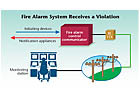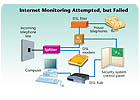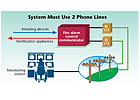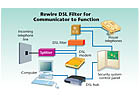To see if you are in sync with the ever-changing monitoring technologies, take our 20 Questions quiz. Then turn to page 27 and find out how you scored.
- Remote video can be used to reduce false alarm dispatches.
- True
- False
- Which type of jack should be used to connect an alarm communicator to a data network?
- RJ-11
- RJ-21
- RJ-31X
- RJ-45
- You can remotely monitor security systems by using a
- LAN.
- WAN.
- Internet .
- Any of the above
- None of the above
- Which of the following can be remotely monitored using a broadband connection?
- Burglary systems
- Fire systems
- Access control systems
- Video systems
- All of the above
- VoIP requires a broadband Internet connection.
- True
- False
- Which of the following can a digital dialer use to transmit signals to a remote monitoring office?
- Cellular network
- POTS line
- VoIP
- Any of the above
- None of the above
- Video images can be sent over a dial-up telephone line as quickly as they can be on a broadband connection.
- True
- False
- Internet-monitored systems can meet UL requirements for line security.
- True
- False
- Which of the following can provide the highest data transfer rate?
- DSL
- Cable modem
- Dial-up telephone line
- They are all the same
- In order to monitor alarm systems over the Internet a fixed IP address is required at the remote location.
- True
- False
- Security systems can be monitored by using a
- POTS line.
- data network.
- broadband connection.
- cellular network.
- Any of the above
- A burglar alarm system with a UL central station certificate requires two telephone lines.
- True
- False
- According to the UL standards you must have one spare digital receiver for how many active digital receivers?
- 1
- 2
- 3
- 4
- 5
- Which of the following is the UL standard for Central Station Alarm Services?
- 639
- 681
- 827
- 1981
- Which of the following is the UL standard for Central Station Automation Systems?
- 639
- 681
- 827
- 1981
- A UL central station certificated burglar alarm system with line security requires two communication paths.
- True
- False
- Remote video images can be sent as an e-mail attachment.
- True
- False
- The transmission speed of remote video images depends upon
- compression technique.
- frame rate.
- type of connection.
- All of the above
- None of the above
- Images received from a remote video system can be saved to a
- CD.
- DVR.
- hard disk.
- Any of the above
- None of the above
- All DVRs have the ability to be connected to the Internet.
- True
- False

Why Did Wally Irk the AHJ?
Wally ‘Larman, the security industry’s most inept technician, installed a fire alarm system for one of his commercial accounts with central station monitoring. He carefully designed the system – following all applicable codes – and received an approval when he filed for the installation. He installed all of the devices as indicated in his filing, using approved wiring, but when the local authority having jurisdiction (AHJ) inspected the system, Wally was given a violation. Can you see what Wally did wrong and what he must do to correct the problem? Answer on page 27.
Installer Gets Tangled up
Wally ‘Larman installed a security system that used an existing Internet DSL line as the primary transmission path to transmit signals to the remote monitoring center. For additional security, Wally decided to use the POTS line as a backup in the event that the Internet connection was down. Wally installed the devices as shown in this diagram and was able to properly send signals over the Internet, but when Wally tested the POTS backup he found that it did not work. Can you see what is causing Wally’s problem and what he must do to correct it? Answer on page 27.20 answers about monitoring
Stop! If you haven’t already taken our 20 Questions about Monitoring quiz, then go back to page 25. If you have, then get ready to score yourself and learn something in the process.Although 20 Questions about Monitoring is not accredited by an official learning institution, we’ve created a scoring guide anyway just for fun.
- Number of correct answers
- Rating
- 20
- Excellent
- 18-19
- Very good
- 16-17
- Good
- 14-15
- Average
- 12-13
- Below average
- 11 or fewer
- Poor
Here are the answers to 20 Questions about Monitoring, which appear on pages 24 and 25.
- a – Verification of an alarm signal is a good application for remote video. It can enable the central station operator to actually see what caused the alarm and if an actual burglary occurred, providing the responding agency with valuable descriptions of the intruders.
- d – An RJ-11 is used to connect standard telephones to the telephone line; an RJ-21 is typically used as a means of terminating all incoming telephone lines; and an RJ-31X is used to connect digital communicators to the telephone line.
- d
- e
- a – VoIP (Voice over Internet Protocol) requires that some type of broadband service be present. It can take the form of DSL, cable, satellite, or any similar broadband service.
- d
- b
- a
- b
- b – A fixed IP address is not required to monitor security systems over the Internet. It may be required for remote programming or for remote video systems.
- e
- b – Two telephones are not required for UL central station burglary systems. Two telephone lines are required for fire systems if using POTS lines.
- e
- c
- d – 1981 is the UL standard for Central Station Automation Systems; 639 is the standard for Intrusion Detection Units; 681 is the standard for Installation and Classification of Burglary and Hold up Alarm Systems.
- b – Only one path is required as long as the path and equipment used are listed for the application. Sometimes two different communication technologies are used, such as digital and radio, depending on how the devices are listed.
- a
- d
- d – Because the images are in a standard computer digital format they can be treated in the same manner as any computer file.
- b – While many DVRs have an Internet capability, not all units are designed to be connected to the Internet.

Answer to: Why Did Wally Irk the AHJ?
Wally received the violation because he used only one telephone line for the digital communicator. In order to monitor fire alarm systems, the communicator must have two supervised POTS telephone lines and also be programmed to send a test signal every 24 hours to the monitoring station. Wally should obtain a second POTS telephone line, install a second RJ-31X jack and connect the line to the digital communicator as shown in this diagram. He also may have to install a dual telephone line module if the existing communicator does not support two telephone lines, and possibly reprogram the control.